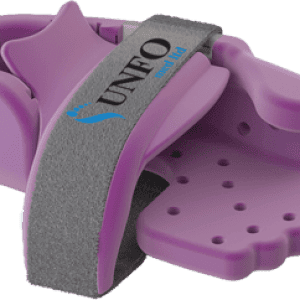The UNFO foot brace
The UNFO foot brace is a revolutionary device designed specifically for the treatment of metatarsus adductus (MTA) in newborns.
UNFO-s is the first short foot orthopedic device that is worn below the ankle – providing a far superior, safer, and less stressful solution than serial casting for the treatment of metatarsus adductus, also known as metatarsus varus, or Forefoot Adduction (FFA).

The brace spares parents and infants the unnecessary physical and social discomfort they may experience with leg casts.
The UNFO foot brace has a number of benefits for both patients and physicians.
While patients enjoy an effective and innovative state-of-the-art treatment, physicians can enjoy more credibility plus the ability to effectively treat patients with MTA.
Additionally, insurance providers gain the benefit of a cost-effective treatment.
The UNFO foot brace is available in two sizes and several colors for both the left and right foot. It is suitable for newborns up to 18 months.
- Easily fitted
- Accurately positioned
- Comfortably worn
- Stress-free treatment for infant and parents
UNFO Foot Brace Components
Components of the UNFO foot brace include:
A. A rigid plastic insert to support the foot. The insert is covered by a soft thermoplastic material to prevent pressure sores.
The medial wall is curves as anti-adductus shape to allow more space at the mid-foot for adequate correction.
The cushion is molded over the first metatarsus and the big toe for better consistent fixation of the foot in the brace.
B. A circular adjustable strap that immobilizes the foot in the brace. Fixed over the medial wall of the brace, the Velcro strap (which features a wide and soft pillow for comfort) can be adjusted by the treating physician as the treatment progresses.
The strap has two major functions:
- To stabilize the heel in the heel cage and the whole foot in the brace, which ensures that the foot remains securely fixed in the brace.
- To apply corrective pressures on the mid foot for adequate realignment of the foot.


